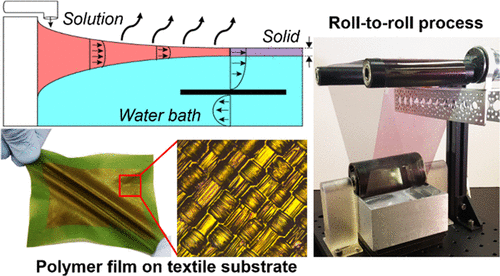当前位置:
X-MOL 学术
›
Chem. Mater.
›
论文详情
Our official English website, www.x-mol.net, welcomes your
feedback! (Note: you will need to create a separate account there.)
Interfacial Drawing: Roll-to-Roll Coating of Semiconducting Polymer and Barrier Films onto Plastic Foils and Textiles
Chemistry of Materials ( IF 7.2 ) Pub Date : 2019-10-16 , DOI: 10.1021/acs.chemmater.9b03343 Rory Runser 1 , Samuel E. Root 1 , Derick E. Ober 1 , Kartik Choudhary 1 , Alex X. Chen 1 , Charles Dhong 1 , Armando D. Urbina 1 , Darren J. Lipomi 1
Chemistry of Materials ( IF 7.2 ) Pub Date : 2019-10-16 , DOI: 10.1021/acs.chemmater.9b03343 Rory Runser 1 , Samuel E. Root 1 , Derick E. Ober 1 , Kartik Choudhary 1 , Alex X. Chen 1 , Charles Dhong 1 , Armando D. Urbina 1 , Darren J. Lipomi 1
Affiliation

|
This paper demonstrates that a thin polymeric film (10–80 nm) can be continuously drawn from the meniscus of a nonpolar polymer solution at an air–water–fluoropolymer interface using a roll-to-roll process: “interfacial drawing”. With this process, it is possible to control the thickness of the film by manipulating the concentration of the solution, along with the drawing velocity of the receiving substrate. We demonstrate the formation of thin films >1 m in length and 1000 cm2 in area, using our custom-designed apparatus. Interfacial drawing has three characteristics which compare favorably to other methods of forming and depositing polymeric thin films. First, the films are solidified prior to deposition, which means that they can be used to uniformly coat nonplanar, rough, or porous substrates. Second, these films can be stacked into multilayered architectures without risk of redissolving the layer beneath. Third, for some materials, the process yields films with superior mechanical compliance for applications such as wearable or flexible devices, compared to films produced by spin-coating. We demonstrate the utility of interfacial drawing by forming thin films of various semiconducting polymers, including the active layers of all-polymer bulk heterojunction solar cells as well as barrier coatings. As part of these demonstrations, we show how floating polymeric films can be transferred easily to diverse substrates, including those with rough and irregular surfaces, such as textiles and fabrics.
中文翻译:

界面绘图:在塑料箔和纺织品上辊涂到卷涂的半导体聚合物和阻隔膜
本文证明,可以使用卷对卷工艺在空气-水-含氟聚合物界面上从非极性聚合物溶液的弯液面连续抽出薄薄的聚合物膜(10-80 nm):“界面拉伸”。通过该过程,可以通过控制溶液的浓度以及接收基板的拉伸速度来控制膜的厚度。我们演示了长度> 1 m和1000 cm 2的薄膜的形成使用我们的定制设备在区域内。界面拉伸具有三个特征,其与形成和沉积聚合物薄膜的其他方法相比具有优势。首先,薄膜在沉积之前先固化,这意味着它们可用于均匀地涂覆非平面,粗糙或多孔的基材。其次,可以将这些膜堆叠成多层体系结构,而无需重新溶解下面的层。第三,对于某些材料,与旋涂生产的薄膜相比,该工艺所生产的薄膜具有优异的机械柔韧性,可用于诸如可穿戴或柔性设备之类的应用。我们通过形成各种半导体聚合物的薄膜(包括全聚合物本体异质结太阳能电池的活性层以及阻隔涂层)来证明界面绘图的实用性。
更新日期:2019-10-17
中文翻译:

界面绘图:在塑料箔和纺织品上辊涂到卷涂的半导体聚合物和阻隔膜
本文证明,可以使用卷对卷工艺在空气-水-含氟聚合物界面上从非极性聚合物溶液的弯液面连续抽出薄薄的聚合物膜(10-80 nm):“界面拉伸”。通过该过程,可以通过控制溶液的浓度以及接收基板的拉伸速度来控制膜的厚度。我们演示了长度> 1 m和1000 cm 2的薄膜的形成使用我们的定制设备在区域内。界面拉伸具有三个特征,其与形成和沉积聚合物薄膜的其他方法相比具有优势。首先,薄膜在沉积之前先固化,这意味着它们可用于均匀地涂覆非平面,粗糙或多孔的基材。其次,可以将这些膜堆叠成多层体系结构,而无需重新溶解下面的层。第三,对于某些材料,与旋涂生产的薄膜相比,该工艺所生产的薄膜具有优异的机械柔韧性,可用于诸如可穿戴或柔性设备之类的应用。我们通过形成各种半导体聚合物的薄膜(包括全聚合物本体异质结太阳能电池的活性层以及阻隔涂层)来证明界面绘图的实用性。


















































 京公网安备 11010802027423号
京公网安备 11010802027423号